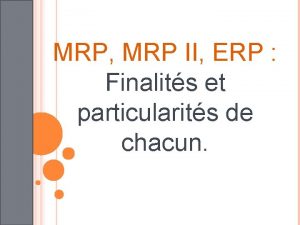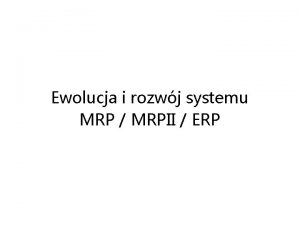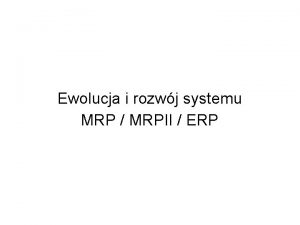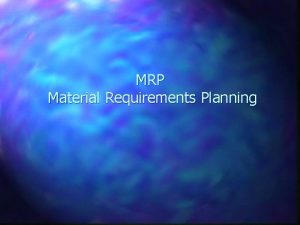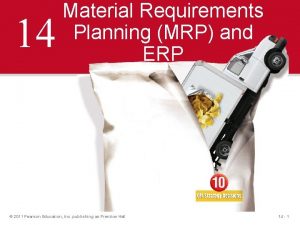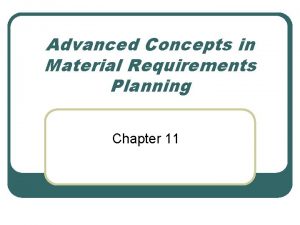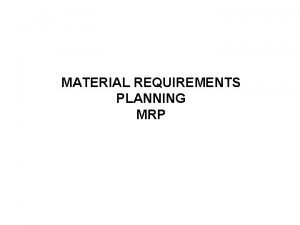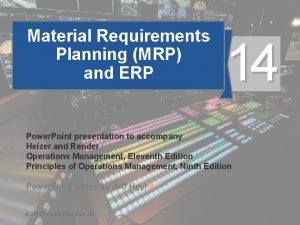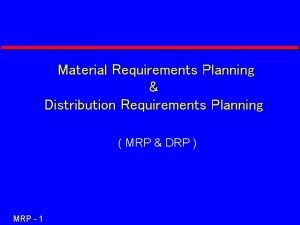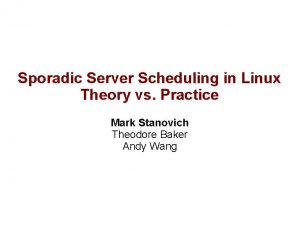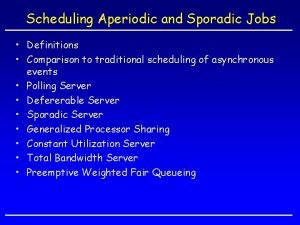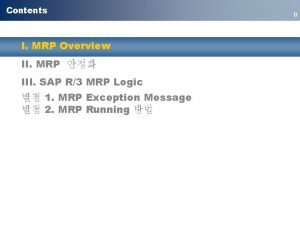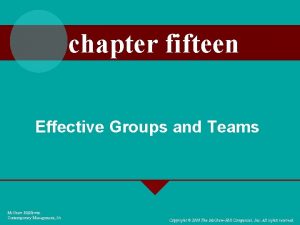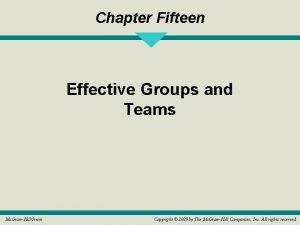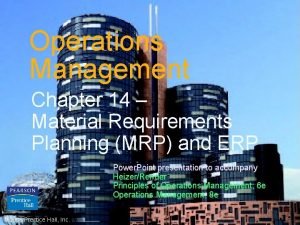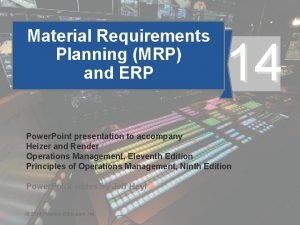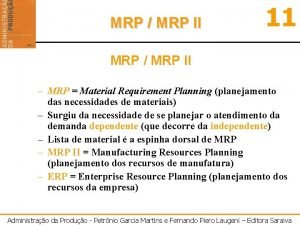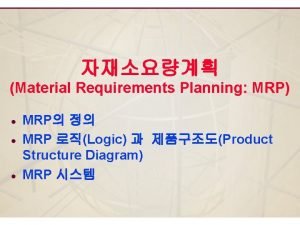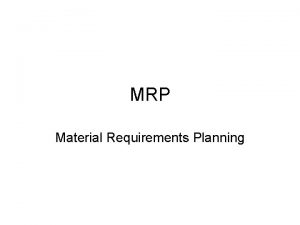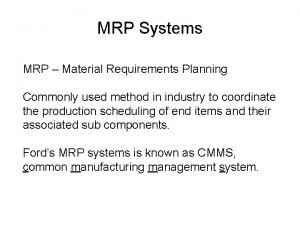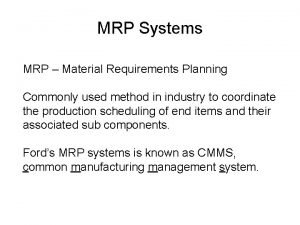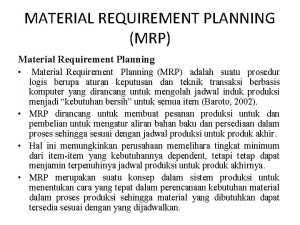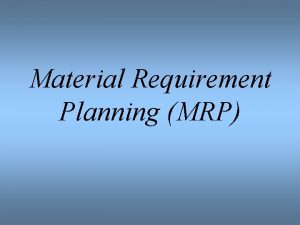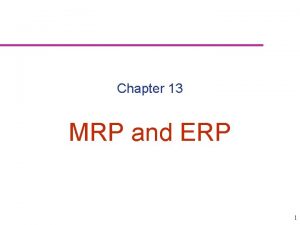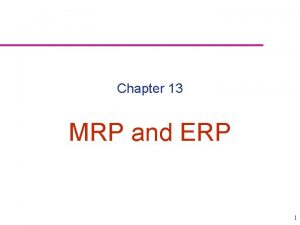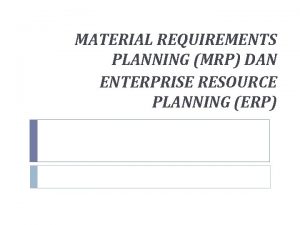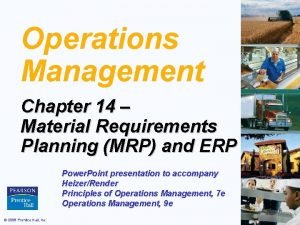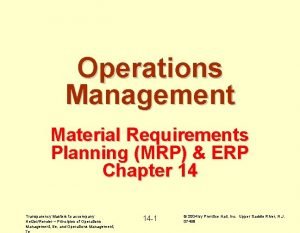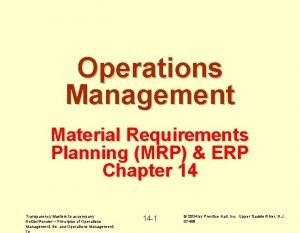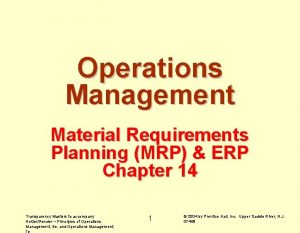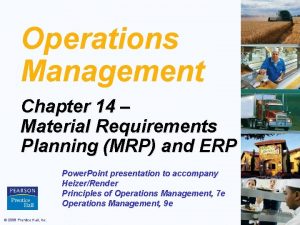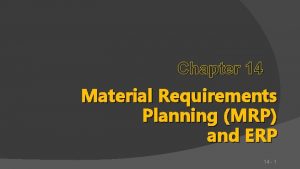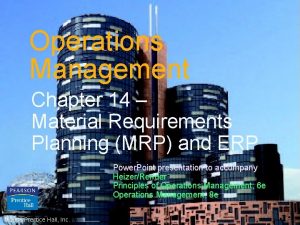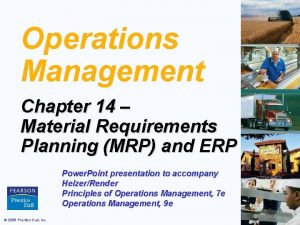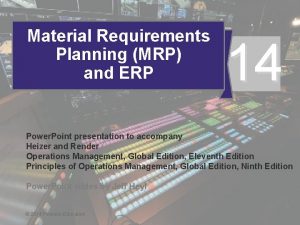Chapter Fifteen Material Requirements Planning MRP for Sporadic
































- Slides: 32

Chapter Fifteen: Material Requirements Planning (MRP) for Sporadic Demand © 2007 Thomson, a part of the Thomson Corporation. Thomson, the Star logo, and Atomic Dog are trademarks used herein under license. All rights reserved.

Outline of Chapter Fifteen 15 -1 The Background for MRP 15 -2 Dependent Demand Systems Characterize MRP 15 -3 The Master Production Schedule (MPS) 15 -4 Operation of the MRP 15 -5 MRP Basic Calculations and Concepts 15 -6 MRP in Action 15 -7 Lot Sizing © 2007 Thomson, a part of the Thomson Corporation. Thomson, the Star logo, and Atomic Dog are trademarks used herein under license. All rights reserved.

Outline of Chapter Fifteen (continued) 15 -8 Updating 15 -9 Capacity Requirements Planning (CRP) 15 -10 Distribution Resource Planning (DRP) 15 -11 Weaknesses of MRP 15 -12 Closed-Loop MRP 15 -13 Strengths of MRP II (Manufacturing Resource Planning) 15 -14 Emerging Power of ERP © 2007 Thomson, a part of the Thomson Corporation. Thomson, the Star logo, and Atomic Dog are trademarks used herein under license. All rights reserved.

15 -1 The Background for MRP • MRP means material requirements planning for specific types of inventory situations. It is well-suited to manage inventories for job shops, and for service operations, where demand for an end product is sporadic. • MRP is an information system that is able to coordinate data about parts and component materials that do not have regular continuous OPP-type usage patterns—characteristic of flow shops. © 2007 Thomson, a part of the Thomson Corporation. Thomson, the Star logo, and Atomic Dog are trademarks used herein under license. All rights reserved.

15 -1 The Background for MRP (continued) • Unlike OPP with quantitative models of optimization, MRP systems are logical organizers of information. MRP link a multiplicity of orders to the processes that will make the finished goods. The systems of connected complexity easily befuddle people, but not the computers that these same people program. • MRP synchronizes parts and components that go into parent products. For example, restaurants have menus that specify what comes on a plate for each dish that can be ordered. If peas and mash potatoes go with meat loaf, then the MRP places orders with suppliers of all ingredients so that they will all be on hand in time to clean, cook, plate, and deliver the dishes that customers request. © 2007 Thomson, a part of the Thomson Corporation. Thomson, the Star logo, and Atomic Dog are trademarks used herein under license. All rights reserved.

The Background for MRP • The first book on MRP was written by Joseph Orlicky, who developed MRP at IBM in 1975. We pay tribute to Orlicky, and to Ollie Wight who carried on the crusade for MRP sponsored by the American Production and Inventory Control Society (APICS). • As Ollie Wight said, MRP is critical because 70% of all stock carried is of the MRP demand-type which is not regular, continuous and independent as is the OPP demand-type. Today, tens of thousands of companies located all over the world use various kinds of MRPs. • Let us also acknowledge that constant improvements in computer memory, speed, and cost, since 1970 have made it possible for MRP systems to tame what would otherwise be massive information overload. © 2007 Thomson, a part of the Thomson Corporation. Thomson, the Star logo, and Atomic Dog are trademarks used herein under license. All rights reserved.

15 -2 Dependent Demand Systems Characterize MRP assumptions are that: 1. Parts and components demands are dependent on the parent demand (also called end product demand). Parts and components have different lead times with different suppliers and must all be treated individually. 2. Demand for the parent is sporadic or lumpy which passes along to the parts and components. Figure 15 -1 illustrates sporadic demand contrasts the MRP assumption with the OPP assumption. Sporadic demand forecasts are feasible. Figure 15 -1 Stock on Hand (SOH) Patterns for OPP and MRP © 2007 Thomson, a part of the Thomson Corporation. Thomson, the Star logo, and Atomic Dog are trademarks used herein under license. All rights reserved.

15 -3 The Master Production Schedule (MPS) The MPS is one of three inputs to the MRP information system. The others are 1) the bill of material (BOM) describing end products, and 2) inventory stock–level reports. Aggregate plans specify what and how much will be made. The MPS converts this information into a time-phased plan with a starting date for the order so that the promised customer delivery date will be met. This “order promising” means that a delivery commitment has been made. Figure 15 -2 illustrates the Time-Phased MPS Function. Figure 15 -2 Note relationship to later use of the terms: Place order = plannedorder release; receive order = planned-order receipt. Examples of parent products include mobile phones, VCRs, DVDs, digital cameras, laptops, bicycles, autos, farm equipment, and industrial machines. Note: Place order = planned-order release; Receive order = planned-order receipt © 2007 Thomson, a part of the Thomson Corporation. Thomson, the Star logo, and Atomic Dog are trademarks used herein under license. All rights reserved.

Cumulative Lead Time Tree • Cumulative lead time for a parent product is found by looking at the longest lead-time path to obtain all of the parts that go into it—as the end- or parent-item. • To assemble A in Figure 15 -3 requires ordering B one week, and C two weeks before the assembly operation is scheduled to begin. • Subassembly C requires 2 weeks for D and 4 weeks for E. The longest ordering chain is six weeks (A+C+E). E must be ordered six weeks before the A-assembly. Figure 15 -3 Cumulative Lead. Time Tree © 2007 Thomson, a part of the Thomson Corporation. Thomson, the Star logo, and Atomic Dog are trademarks used herein under license. All rights reserved.

Total Manufacturing Planning and Control System (MPCS) • In prior steps, aggregate scheduling led to an authorized production plan. This, in turn, produces the Master Production Schedule (MPS) which intends to satisfy customer order expectations as well as specific orders on hand. • Once the MPS is accepted and authorized, the planning process proceeds to details of scheduling that are the province of the MRP system. The steps are flow charted in Figure 15 -4. This process is called the total manufacturing planning and control system (MPCS). Figure 15 -4 © 2007 Thomson, a part of the Thomson Corporation. Thomson, the Star logo, and Atomic Dog are trademarks used herein under license. All rights reserved.

Inputs and Outputs of MPS • Table 15 -3 shows an MPS chart. One is created for every parent product. This is the output of the middle step (labeled MPS) for the total MPCS in Figure 15 -4. • The MPS chart in Table 15 -3 indicates that 20 units of the parent product are to be made in the second week ahead from now. It if takes 4 weeks (LT = 4) to order parts that are needed for the parent product, then the order should have been placed 3 weeks before week 1. • 45 units are required 5 weeks ahead. The planned order must be released now in week 1. • Order in week 5 for 60 units required in week 9. Table 15 -3 MPS Chart for Specific Parent Product Weeks ahead Gross (amount) requirements 1 2 20 3 4 5 45 6 7 8 9 60 © 2007 Thomson, a part of the Thomson Corporation. Thomson, the Star logo, and Atomic Dog are trademarks used herein under license. All rights reserved.

MPS: Inputs and Outputs • Master production schedulers create make-build specs for each parent product subject to the Inputs and Outputs shown in Figure 15 -5. • The MPS combines customer orders on hand with (hard) parent product forecasts. Customer and order priorities and best use of available resources are other important inputs. • Outputs go to the MRP for planned order releases. Figure 15 -5 © 2007 Thomson, a part of the Thomson Corporation. Thomson, the Star logo, and Atomic Dog are trademarks used herein under license. All rights reserved.

Inventory Environments and Order Promising • Order promising commitments by sales and production’s order fulfillment goals are matched and coordinated by the MPS. Inventory environment (IE) for the parent products is the systems driver. • Make-to-stock (MTS) has latitude in what is scheduled. P/OM’s objective is to provide excellent service to customers by maintaining proper stocks of inventories to meet demand due dates. • Make-to-order (MTO) is an environment where finished goods inventories do not exist to support service to customers. There is great dependency between sales and P/OM which requires capacity and materials to meet delivery expectations. MPS/MRP are constantly changing. • Assemble-to-order (ATO) is an (IE) where end-items are built from subassemblies. The MPS ensures correct stock-on-hand (SOH) for the kits to meet due dates. Often, the MPS is primarily concerned with making parts and only secondarily with parent products. © 2007 Thomson, a part of the Thomson Corporation. Thomson, the Star logo, and Atomic Dog are trademarks used herein under license. All rights reserved.

Bill of Material (BOM) • The Bill of Material (BOM) for a dinner party is the cook’s shopping list organized by dishes and what is required for each one of them. • MRP cannot be used without bills of material. However, MRP did not invent these detailed lists of information about assemblies, subassemblies, sub-subs, etc. • BOMs were used by P/OM long before MRP was created (1975). • Figure 15 -8 shows a multi-level BOM with some detailed coded information about levels where the parent is at level zero. These multi-level product structures use an explosion of parts. Orlicky’s word to reflect that no detail should be missed. Figure 15 -8 © 2007 Thomson, a part of the Thomson Corporation. Thomson, the Star logo, and Atomic Dog are trademarks used herein under license. All rights reserved.

15 -4 Operation of the MRP • Figure 15 -9 shows Inputs and Outputs of the MRP system. • MPS and BOM have been discussed. It’s not surprising that the IRF is a critical third input to the MRP. • Output driver is the planned-order timetable for planned-order releases. In some inventory environments changes are more of a problem than in others. Figure 15 -9 © 2007 Thomson, a part of the Thomson Corporation. Thomson, the Star logo, and Atomic Dog are trademarks used herein under license. All rights reserved.

15 -5 MRP Basic Calculations • Gross requirements GRt for end-items for week t are required by MRP and stated by the MPS. Inventory data are on file for the prior week’s stock-on-hand, SOHt-1. • And there may be some open orders to be received at the beginning of week t, called Scheduled Receipts, SRt. • Gross requirements less projected stock-on-hand at time t are called Net Requirements, NRt. • NRt = GRt - SOHt-1 - SRt. • The determination of NRt is called netting. Based on NRt and order policies, planned-order receipt, PRt, and planned-order release times can be calculated. © 2007 Thomson, a part of the Thomson Corporation. Thomson, the Star logo, and Atomic Dog are trademarks used herein under license. All rights reserved.

15 -6 MRP in Action • The best way to understand MRP is to simulate the action. • Some scenarios covered in Section 15 -6 include: 1. Lot-for-lot ordering; no parts-sharing parents; SOH = 80; LT = 2; @ level one. 2. Lot-for-lot ordering; no parts-sharing parents; SOH = 40: LT = 1; @ level two. 3. Lot-for-lot ordering; no parts-sharing parents; SOH = 0; LT = 1; @ level two. 4. Economic order quantity (EOQ) for a part that shares two parents; SOH = 80; LT = 1; @ level 1 © 2007 Thomson, a part of the Thomson Corporation. Thomson, the Star logo, and Atomic Dog are trademarks used herein under license. All rights reserved.

15 -7 Lot Sizing • Lot-for-lot sizing is one of the simplest ordering methods. However, it places more orders than other methods which order less frequently in larger quantities. • Lot-for-lot is MRP’s version of just-in-time. • Lot-for-lot means buying the exact amount in each cell with a Net Requirement (NRt); using the appropriate Lead Time (LT). • Lot-for-lot means that planned-order release (and planned-order receipt) are equal to NRt. • An alternative is to group together the requirements of several NRt cells to gain volume discounts, smaller number of orders, and other efficiencies. © 2007 Thomson, a part of the Thomson Corporation. Thomson, the Star logo, and Atomic Dog are trademarks used herein under license. All rights reserved.

• § § 15 -8 Updating There are two approaches for updating the MRP: Regeneration MRP—MPS is totally reexploded down through all BOMs, to maintain valid priorities. Planned-order releases and NRt are recalculatedfrom scratch. Perhaps weekly timing. Net change MRP—MRP is retained in the computer. When a change is needed in requirements, BOM listing, or open-order inventory status, partial explosion and netting are used only for affected parts. Too much netting accumulates errors but allows rapid response and avoids costly regeneration. Timing is as needed which could be hourly, or even less, in times of stress. © 2007 Thomson, a part of the Thomson Corporation. Thomson, the Star logo, and Atomic Dog are trademarks used herein under license. All rights reserved.

15 -9 Capacity Requirements Planning (CRP) • CRP is an extension of MRP which is required when capacity must be readjusted because the MRP system delivers a plan that is not feasible with existing capacity configurations. In Figure 15 -13 see MR > RA. Figure 15 -13 © 2007 Thomson, a part of the Thomson Corporation. Thomson, the Star logo, and Atomic Dog are trademarks used herein under license. All rights reserved.

Rough-Cut Capacity Planning (RCCP) • RCCP uses approximation methods to determine if there is sufficient capacity to accomplish objectives. RCCP occurs when the aggregate plan is being transformed into the MPS. • RCCP checks to see if there is enough capacity using a Bill of Resources (BOR). • BOR is a listing of key resources needed to make one unit of each item (or GT family) for which production is planned. • RCCP and BOR are pre-MRP whereas, CRP is post. MRP © 2007 Thomson, a part of the Thomson Corporation. Thomson, the Star logo, and Atomic Dog are trademarks used herein under license. All rights reserved.

15 -10 Distribution Resource Planning (DRP) • DRP refers to distribution resource planning. It is part of MRPII (See Section 15 -13 and Figure 15 -15 for discussion of “the big MRPII picture. ”) When DRP has this all-inclusive view of supply chain management, it is called DRP 2. • DRP 1, on the other hand, is defined as the time-phased order point approach used to “explode” planned orders at the branch warehouse level. DRP 1 is the application of MRP logic in tracing parts to endproducts. • DRP 2 extends distribution requirements planning methods of DRP 1 to the inter-functional business system. It does this by applying the total systems point of view to strategic planning, whereas DRP 1 is tactical in nature. © 2007 Thomson, a part of the Thomson Corporation. Thomson, the Star logo, and Atomic Dog are trademarks used herein under license. All rights reserved.

15 -11 Weaknesses of MRP • MRP is vulnerable to variability in lead times. Parent products cannot be made if parts or components are undelivered. • MRP is supposed to do away with need for safety stock. P/OM may take protective measures such as lengthening estimated LT to offset delivery delays. Such “safety time” translates into added stock being carried as if it were buffer or safety stock. • Order cancellations upset the system and require extensive “regeneration” or “net change” calculations. This is time consuming and delays production. • Data errors, especially cumulative ones that occur with net change MRP, deteriorate systems performance. © 2007 Thomson, a part of the Thomson Corporation. Thomson, the Star logo, and Atomic Dog are trademarks used herein under license. All rights reserved.

15 -12 Closed-Loop MRP • The core of the closed-loop MRP is the traditional material requirements planning function. Closed-loop has additional planning functions added which make it significantly more powerful as a systems model. Figure 1514 shows CRP and DRP 1 with feedback links to make corrections and adjustments. Figure 15 -14 © 2007 Thomson, a part of the Thomson Corporation. Thomson, the Star logo, and Atomic Dog are trademarks used herein under license. All rights reserved.

15 -13 Strengths of MRPII (Manufacturing Resource Planning) • MRPII entails total manufacturing resource planning as part of the strategic business plan. At the top of the chart in Figure 15 -15 is strategic business planning. • Everything else may seem the same but it is a different game. Because strategic planning drives MRPII, this permits inclusion of product mix, advertising, new computer systems, etc. Figure 15 -15 © 2007 Thomson, a part of the Thomson Corporation. Thomson, the Star logo, and Atomic Dog are trademarks used herein under license. All rights reserved.

15 -14 Emerging Power of ERP • MRPII is the basis and foundation for Enterprise Resource Planning (ERP). • Transformation of MRPII to extensive applications of ERP is accomplished by converting the Business Planning box at the top of Figure 15 -15 into an Enterprise-Wide Planning Box that spans the globe. Broad strategy creates the conditions for detailed tactics. Success/failure are feedback for adjustments. • Experiences of ERP providers (such as Oracle, SAP, IBM, Microsoft, and other smaller consulting firms that cannot spend as much on advertising, but are in the business), is that ERP has many pitfalls— some can be avoided, but are the price for gaining total control of the expanded global enterprise. © 2007 Thomson, a part of the Thomson Corporation. Thomson, the Star logo, and Atomic Dog are trademarks used herein under license. All rights reserved.

Spotlights in Review 15 -1 Innovation: Everyone Has Something to Say about It • People tend to think that innovation is a property—and that you can’t have enough of it. The derivation from Latin, innovare, to renew, raises the point of when to convert the old to the new. Old can be tried and true, while new can be at risk of failure. This view is borne out by facts that a small percent of new products succeed enough to have been worth the time and money. • There are ways to manage innovation to improve results and share risk. Partnerships to bring various kinds of expertise to bear are worthwhile. Too new, too different, and too risky may explain why large R&D budgets of established firms seldom motive them to venture into new initiatives. Keuffel & Esser (leading slide rule firm) did not survive calculators. Brush Electric Co. (leader in carbon arc lamps) could not shift to tungsten and the light bulbs of the 1900 s. • Continuous innovation (kaizen) or radical reengineering (REE) are options open to every company. Startups are free of old baggage and have greater flexibility to innovate than established firms. © 2007 Thomson, a part of the Thomson Corporation. Thomson, the Star logo, and Atomic Dog are trademarks used herein under license. All rights reserved.

Spotlights in Review 15 -2 The Fallacy of Pursuing Local Optimums • Dr. Eliyahu M. Goldratt, author of The Goal and The Race, is world renowned for developing startling, yet eminently sensible, new methods for production control. His management philosophies and systems of thinking about problems continuously challenge companies to “break outside of the box” of conventional practices. • Early in his career, Goldratt developed the fundamental concepts for bottleneck-based finite scheduling. He concluded that optimizing production scheduling in isolation from other business variables does not lead to higher productivity or attainment of company goals. The evolution of these ideas he called the Theory of Constraints (TOC). • As time progressed these theories captured ever-larger slices of all management activities including project management and marketing. The fundamental base was the P/OM system extended to avoid local optimums. TOC guides the search for global optimization with benefit accruing to all who participate in Dr. Goldratt’s systems approach. © 2007 Thomson, a part of the Thomson Corporation. Thomson, the Star logo, and Atomic Dog are trademarks used herein under license. All rights reserved.

Questions You Can Now Answer • What is the difference between dependent and independent demand systems? Can you provide an example of each? • What differences differentiate OPP and MRP? • When is MRP preferred to OPP for inventory management? • What important function does the master production schedule play? • How does the bill of material differ from the MPS? • What kinds of forms are used for the BOM? • What are the data inputs to the MRP? • What are the information outputs from the MRP? • What is the lot sizing method used for ordering with MRP? © 2007 Thomson, a part of the Thomson Corporation. Thomson, the Star logo, and Atomic Dog are trademarks used herein under license. All rights reserved.

Questions You Can Now Answer • How can capacity requirements planning (CRP) be described? • Under what circumstances should the planner use distribution requirements planning (DRP = DRP 1)? • Under what circumstances should the planner use distribution resource planning (DRP = DRP 2)? • How does DRP 1 relate to replenishing inventory at the branch warehouse. • How does DRP 2 link key resource planning to the supply chain? • What are information coding systems? © 2007 Thomson, a part of the Thomson Corporation. Thomson, the Star logo, and Atomic Dog are trademarks used herein under license. All rights reserved.

Questions You Can Now Answer • How do information coding systems capture demands for parts for more than one product? • Do information coding systems permit comprehensive item ordering? • Why is it said that information coding systems are an integral part of planning for the firm as a whole? • How do parent items relate to coding systems? Give an example. • What are the differences between MRP and closed-loop MRP? • What are the differences between closed-loop MRP and MRP II? • Why is MRP said to be a true innovation? • Is ERP a bigger innovation than MRPII? © 2007 Thomson, a part of the Thomson Corporation. Thomson, the Star logo, and Atomic Dog are trademarks used herein under license. All rights reserved.

Study Areas Ahead • Spotlight 16 -1 titled, The Challenge of Scheduling Production and Operations: Discussion Based on the Ancient Puzzle Game, The Tower of Brahma (also known as the Tower of Hanoi) is a great opportunity to learn about production scheduling and have some fun. • Understanding the loading function and Gantt load charts makes it possible to comprehend aggregate scheduling, and the workings of the job shop. Loading is coming in Chapter 16. • Spotlight 16 -2, The Pursuit of Clean Air, is critical for management to understand how important P/OM has been and continues to be in this pursuit. • Contingency planning is not theoretical. It can protect against disaster. P/OM must understand what it does and how to use it. © 2007 Thomson, a part of the Thomson Corporation. Thomson, the Star logo, and Atomic Dog are trademarks used herein under license. All rights reserved.
 Mrp et erp
Mrp et erp Planowanie zasobów produkcyjnych
Planowanie zasobów produkcyjnych Mrpii
Mrpii Material requirements planning
Material requirements planning Lot sizing techniques in mrp
Lot sizing techniques in mrp Material requirements planning concepts
Material requirements planning concepts Mrp system
Mrp system Explain mrp
Explain mrp Mrp/drp
Mrp/drp Sporadic server
Sporadic server Sporadic jobs
Sporadic jobs Sporadic employment
Sporadic employment Sporadic e map
Sporadic e map Sporadic disease
Sporadic disease Sporadic disease
Sporadic disease Sap procurement type
Sap procurement type Fifteen william stafford
Fifteen william stafford Eleven twelve thirteen fourteen fifteen
Eleven twelve thirteen fourteen fifteen Fifteen by william stafford
Fifteen by william stafford Either my shoes or your coat is, are always on the floor
Either my shoes or your coat is, are always on the floor Dynaway eam
Dynaway eam Team fifteen mc
Team fifteen mc Types of task interdependence
Types of task interdependence The 15 cabinet departments
The 15 cabinet departments Fifteen mc
Fifteen mc Mrp 2 in operations management
Mrp 2 in operations management Ideal characteristics of dental products
Ideal characteristics of dental products Material requirement planning table
Material requirement planning table Engineering drawing symbols and meanings
Engineering drawing symbols and meanings Rsq formula in standard costing
Rsq formula in standard costing Non material culture
Non material culture Non material culture examples
Non material culture examples Material and non material culture examples
Material and non material culture examples
